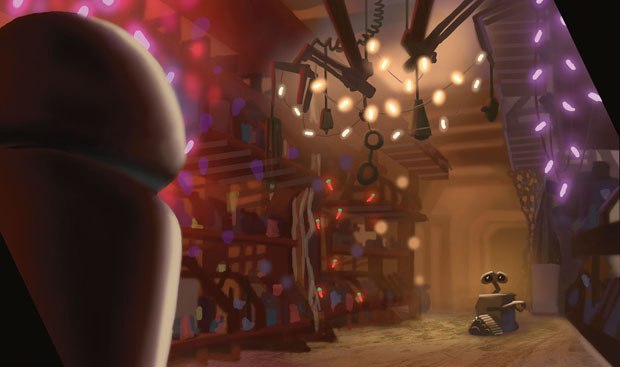Fred Patten reviews a must-have book for fans of Pixar's individual films and students of modern animation in general.
San Francisco, Chronicle Books, November 2011, hardcover 978-0-811879-63-7 $50.00 (317 [+ 3] pages).
Yarst! I am semi-paralyzed since a stroke in 2005, and this book is really too massive & heavy to be held with only one hand. I don’t know how much it weighs, but WHEW!
The colorscripts – “I first learned what a color script was early on in the development of Toy Story. Ralph Eggleston, the production designer, had told me he was going to put one together, but I didn’t know exactly what to expect when I stopped by his office to review it for the first time.” … John Lasseter’s Foreword, p. 7 – fill over half of this huge, slick-paper doorstopper. There are colorscripts for Pixar’s features chronologically from Toy Story in 1993 through Cars 2 in 2010-2011, followed by colorscripts for Pixar’s fourteen most recent shorts. The colorscripts for the features average ten to twenty pages each; those for the shorts one to two pages. These fill the first 193 pages.
“The Worlds”, from page 194 to 317, are “A gallery of visual development art, 1994-2010”; a collection from “the Pixar Living Archive” of its full-color conceptual and layout paintings, from gouache and watercolor to digital art. Each piece of art is signed, making this a gallery of the work of Teddy Newton, Ralph Eggleston, Geefwee Boedoe, Bill Cone, Paul Topolos, Steve Johnson, Lou Fancher, Harley Jessup, Ricky Nierva, Lou Romano, Dice Tsutsumi, and others of Pixar’s leading artistic staff from 1993 through 2011.
Amidi’s informative introductory text traces the history of colorscripts from 1930s live-action films through their perfecting for animated features by the Disney studio in the 1940s and UPA in the 1950s, and their further evolution by the Pixar studio. “The Pixar Living Archive” is literally that. Ever since an electrical fire destroyed most of Aardman Animations’ archives in 2005, Pixar’s artistic history has been kept “in a building that has a waterless fire suppression system. Should a fire erupt, bursts of a colorless, odorless halocarbon called heptafluoropropane will flood the archives, snuffing out the fire while keeping the artwork safe and secure. The facility is climate controlled with humidity maintained at an average of 50 percent (plus or minus 5 percent) and temperature at 70 degrees (plus or minus 2 percent), a stable environment that slows the natural deterioration of art materials.” (p. 196).
Above all, this is a monumental artistic feast of Pixar’s artwork from its first theatrical feature to the present. It would have been interesting to have seen some of the pre-1993 artwork for Pixar’s early shorts like Tin Toy and Knick Knack. But The Art of Pixar is full (and HEAVY!) enough as it is. “Directors, in particular, like colorscripts. For the first time in the production, they are able to see their entire film in color, in one place, on a single board. […] Colorscripts evolve in an organic manner as directors and production designers refine their thinking about a film.” (p. 11). For the fans of these individual films, and students of modern animation in general, The Art of Pixar is a must-have book!
--
Fred Patten has been a fan of animation since the first theatrical rerelease of Pinocchio (1945). He co-founded the first American fan club for Japanese anime in 1977, and was awarded the Comic-Con International's Inkpot Award in 1980 for introducing anime to American fandom. He began writing about anime for Animation World Magazine since its #5, August 1996. A major stroke in 2005 sidelined him for several years, but now he is back. He can be reached at fredpatten@earthlink.net.










